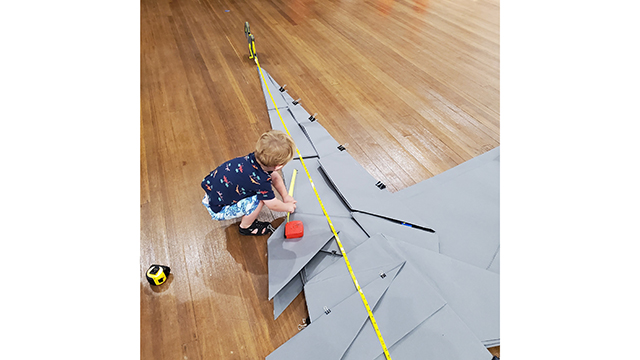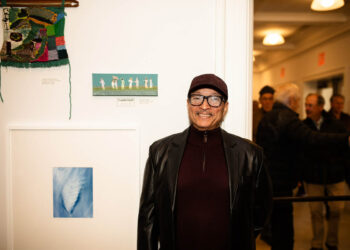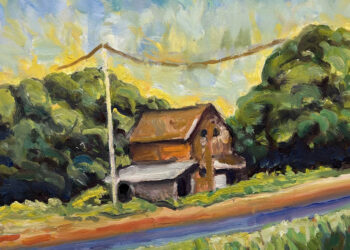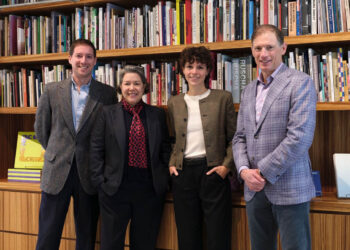Last August, a Guinness World Record was set when origami experts Shrikant Iyer and Paul Frasco constructed the world’s largest origami dragon. The duo created the magnificent masterpiece at Southampton Arts Center (SAC).
“Making large origami, usually nowadays you call it oversized folding, it’s not a new concept. A few years ago at OrigamiUSA, which is a nonprofit organization based in New York City, they have an annual convention every year, and one of the activities that happened was an oversized folding competition,” Iyer told us. “Everybody would come, you would make teams, they would all fold together, and then they would display their crazy whatever they were making – sometimes it was very simple and some were very intricate. You get 45 minutes to do it from start to finish, it was usually nine foot squares, so it’s pretty big.”
He continued, “That’s how the idea had started, the idea in the world of the origami community has been there since then. That was popular, it kept going and going and going, and it’s been a tradition now at some of the larger conventions that have the space to do something like this.”
The attempt at the Guinness World Record has been nearly ten years in the making. “I’ve organized an event for 13 years called Origami Heaven, and around 2012, at Stony Brook, was one of those years when we did ‘extreme origami.’ We had all kinds of extremes of origami. At that time, Paul – who I worked with on this project, he had designed this dragon model and it was quite popular. It had just been published and it was kind of a big deal. So, he made a big dragon up for the exhibit,” Iyer explained. “He tried to submit it to the Guinness Book of World Records, but you have to submit a proposal of what you think the record should be. He submitted the idea of making the largest dragon that was accepted, but he needed a lot of recording, photos, and measurements. They were quite strict with what they wanted, so that went unrecorded. Since then, he has tried to do it again.”
While in the past the timing had never quite worked out, both had time to dedicate to the project during the pandemic. “Because I organize these events, he kept coming to me saying, ‘I want to do it this year.’ For some reason it never worked out in doing it with the origami convention in New York for various reasons. Ultimately, two years ago, I decided it was the last year I was going to do the convention,” Iyer said. “He just had a baby, so that was not going to happen. In 2020, when COVID happened and everybody was cooped up, nobody was getting together, nothing was happening, I thought I can’t organize an event, so I called up Paul. We were chatting, and I said, ‘Well, you know, if you can certify that you and your family do not have Coronavirus and I don’t have COVID, why don’t we get together and make this design – and this time we’ll follow all the procedures that’s required.'”
Frasco was on board, but then the duo faced the challenge of finding a location. “He lives in New York City and I live out here [the Hamptons],” Iyer explained. “They visit us every once in a while, but it became a little bit more complicated, because now we have a pandemic. It has to be in a public venue, because people should be able to come and see.”
Iyer reached out to Amy Kirwin, Southampton Arts Center Artistic Director, and SAC gladly agreed to host the artists. “I would definitely say that it was always difficult to turn the paper over. It seems like a simple thing to turn paper over, but it’s very hard to flip a paper that’s that big,” Iyer said was the most difficult aspect of creating the dragon. “In the first few folds, your paper doesn’t get much smaller, you’re still dealing with a tight shape that’s at least 20 feet long. If you flip it, and you don’t do it correctly, you have the risk of the paper ripping and the layer coming undone.”
 |
|
Measuring the magnificent creation was a must. (Photo: Courtesy of Shrikant Iyer) |
At times, the duo needed to utilize SAC staff members. “It was really, really challenging, especially with only two people. There were times we sought out help from the people who work for SAC. They didn’t have to do anything, but just hold it,” he said. “It was really hard, because you really don’t know what it is going to do. You have all these things that are happening, and then you have no choice because you really do have to flip it over because there is a symmetry to it.”
“That would have been the other thing, when things are getting three dimensional, we had to design an armature to hold the dragon,” he added. “Truly, I would say the one thing we had the hardest time with was right in the very beginning when we had to turn the paper over. And you can’t have a dress rehearsal, so that was really challenging, because we didn’t know what was a good idea and what was a bad idea.”
While the origami dragon was certified at 12 feet, 8.75 inches long, 6 feet, 6.5 inches high, and 3 feet, 11.5 inches wide, the paper used was actually significantly larger. “We wanted to keep it manageable, because the paper was quite a bit larger than what had ever been attempted. This was a whole ‘nother level. Normally, you could have teams of three, four people,” he reflected. “But now, because of COVID, we said it’s going to be two because we can’t trust any more people. Luckily, the SAC has this big auditorium that was not being used. So, we had the space to do it, and we were in a temperature controlled space and didn’t have to worry about rain – and then once the dragon was made, we could keep it there for a few days.”
The actual fête took two days. “What we decided to do was cut the paper the first day, because it came in a big long roll,” he shared. “And again, we had to take time to pause, take photos, measurements, they even wanted videos of the ruler from the start to the finish. We had to make sure that we were getting the evidence as we were progressing. So, we decided to do the paper prep the first day, and do the actual folding the second day.”
For Iyer, origami has been a longtime passion. “I’ve been folding since I was nine, so that would be for 33 years. I grew up in India and it didn’t require any formal training, so it was very accessible. Paper was everywhere and I’d just use my hands and paper. I didn’t have to go to the store and buy anything,” he shared. “I kind of grew up in a place that availability… Amazon.com didn’t exist, there was no shop to go buy things. What I liked was it was accessible. On afternoon TV, there was an origami program that would happen every afternoon. I would turn it on, it was about 15 minutes, and they would go through one, sometimes two models. They would fold it once and they would do one review. So, if you missed a step, you can hopefully catch up. And that’s how I started.”
There’s a certain something about watching the designs come to life that still amuses Iyer. “There was always something very magical about it. You started with a square/rectangle paper, and then you fold, and the first steps everybody can do, but it’s that moment when something forms, and you start seeing what it’s going to become – that moment is quite magical. The more you do it, the better you do it, and the designs get very attractive. Especially as a child, I always thought that’s so brilliant, that boom it’s suddenly one move and from this funny, geometric shape it became something. You still have steps to go, but you can start seeing it become something – kind of like the birth of a design, if you will.”
Setting a Guinness World Record is an incredible accomplishment in itself, but the artists’ efforts turned into something so much bigger. “By the end of this whole process, it became more about this extraordinary time we live in. Most of the origami community is now quite divided, because we are all online and we’re all meeting online. There’s just a complete absence of people getting together and doing anything together. This was kind of, in a way, the best we could do in an extraordinary time was to accomplish something extraordinary. It became something else, in a way. It became about a live folding event with people sort of coming together. There was the online component, we used Instagram Live for people to look at it. And then, of course, there was the local community, people went and looked and saw what was going on and had their pictures taken with the dragon. It was interesting that it became more about achieving something extraordinary in the strange time that we live in – and the fact that we’re not coming together in person, if you will, but in a way of overcoming that in a creative way.”











